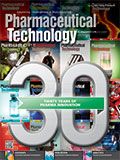Tooling Up for Pharma
Pharmaceutical Technology Europe
Instrumentation advancements over the past 30 years have certainly enabled greater efficiency in pharma development and analysis despite slow adoption by the industry.
Instrumentation and technology have been crucial in the pharma industry over the years, allowing for advancements in manufacturing speed and efficiency and improving analysis sensitivity. In a special interview, Bjoern-Thoralf Erxleben, senior manager-European Innovation Centre of Shimadzu Europa, spoke with Pharmaceutical Technology Europe about the past, present, and future of analytical instrumentation within the pharma industry.
Vast improvements
PTE: What advancements in analytical instrumentation do you believe have been the most integral to the pharma industry?
Erxleben (Shimadzu Europa): Analytical instruments have vastly improved over the past three decades. There has been digitalization, miniaturization, automation, as well as new technologies, methods, and features, and there have been improvements in robustness, routine capabilities, and specifications all the way up to design.
Looking at liquid chromatography (LC) as an example, this technique has progressed from 200/300 bar pressure up to more than 1000 bar for routine systems. The most tremendous improvements, however, have occurred in mass spectrometry (MS). Over the years, MS instruments, and LC–MS systems in particular, went through a revolutionary development. In the pharma industry, the wide use of MS and MS–MS methods in analysis has enabled shorter development cycles and process changes. It must be noted as well, that major improvements in column technology, such as smaller particles, new chemical modifications, and new fused core columns, have made LC more suitable for a wider variety of pharma applications.
Currently, interest in supercritical fluid chromatography has risen, largely driven by ecological aspects. Other reasons behind the increased interest are that technological improvements allow for easier operation and routine stability compared with more traditional techniques.
Computer technology, volume of data, and processing speed are also drivers of market change as complex techniques can be performed routinely and conveniently. Last but not least, for analytical instrumentation in general, regulations for data handling, integrity, and compliance have been applied that improve and maintain safety of, and confidence in, final pharma products.
Overcoming slow adoption
PTE: How have instrument developers overcome the challenge of slow adoption of technological advancements?
Erxleben (Shimadzu Europa): When discussing pharma markets, it is important to differentiate between R&D on one side and production, quality control and quality assurance (QA/QC) on the other. Indubitably, new development and directions require advances in technologies, higher sensitivity, and constant improvements of existing systems. At the same time, however, samples still have to be measured routinely and quality of the results must be ensured; standard workflows and established procedures perhaps cannot or should not be changed often and/or immediately.
The challenges for the manufacturer are to ensure that workflows can be maintained without requiring big changes and re-certification. This not only covers the introduction of new instruments and software, but also new concepts for the education of users and ways to adapt analytical instrument operation easily. Modern teaching tools such as e-learning and interactive sessions are possible solutions; applying more artificial intelligence (AI) and machine-to-machine learning scenarios are others. This will change the role of the user in future to become more of an observer or supervisor who only intervenes in cases of error during the analytical process, based on standard procedures proposed by the system.
Furthermore, compliance with regulations and the use of registered methods is a subject where both parties (vendor and user) have to maintain dialogue with the authorities to shorten processes and increase flexibility for adaptations without infringement of existing rules and guidelines.
Advances for the future
PTE: In the future, what technological/instrumentation advances do you see as potentially creating a paradigm shift within pharma?
Erxleben (Shimadzu Europa): Today’s trends towards AI, automation, and big data are still just at the preliminary phase. Data handling and IT infrastructure will change in line with the implementation of AI in the pharma industry.
The number of small molecules in development is already declining, and biopharmaceuticals are becoming more prominent in the industry. Targeted medication based on genetic-profiling and specially designed therapy will change the classical pharma development direction over the coming years. Personalized medicine will take more effort from R&D groups, require a closer link to hospitals/patients than now, and will require less production capacity.
In general, new and optimized production procedures will be established to meet the needs of the therapies in development. These processes will be fully controlled and have automated analytical arrays, which will offer direct feedback on parameters. Further improvements in separation and MS technology may lead to advancements in analytics.
For the most part, traditional analytical arrays will be replaced by ‘targeted screening’ and only in the case of non-conformity will detailed analysis be performed. This does not mean that traditional analytics will stop; on the contrary, sensitivity and operability will be even more important than now.
New methods and instrumentations will emerge in the future, in addition to those that are currently established to reduce analysis time. The traditional or ‘classic’ analysis in pre-clinical and clinical trials will be more in-depth for deviations from ‘standard’ results. As long as metabolism pathways and structures are known, screening for molecules can be performed with less (or nearly no) separation, which saves time and enables automation using AI approaches.
Non-destructive methods will also be increasingly required and should be prioritized as fast scanning of products is necessary to identify fake products.
Article Details
Pharmaceutical Technology Europe
Vol. 31, No. 8
July 2019
Page: 24
Citation
When referring to this article, please cite it as F. Thomas, “Tooling Up for Pharma,” Pharmaceutical Technology Europe 31 (8) 2019.

Pharmaceutical Tariffs Are Imminent: How Industry is Bracing for Impact
April 16th 2025On April 14, 2025, the Trump Administration launched a national security-driven investigation into pharmaceuticals, a move that will likely result in tariffs being placed on pharmaceutical drugs, ingredients, and other components that are imported from outside of the United States.